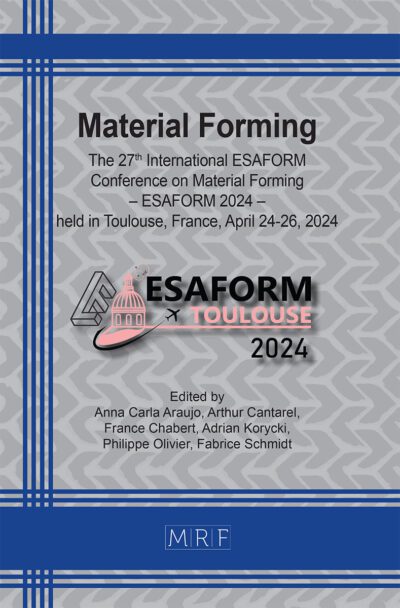Inverse identification of anisotropic plasticity model parameters using FEMU and a heterogeneous test
Mafalda Gonçalves, Sandrine Thuillier, António Andrade-Campos
Abstract. Accurate characterization of the anisotropic plastic behavior of sheet metals is critical for predicting their performance in forming operations. Traditional testing methods often struggle to capture complex material responses under varied loading conditions. This study focuses on combining a heterogeneous mechanical test with the Finite Element Model Updating (FEMU) technique to inversely identify the parameters from an anisotropic plasticity model. The experiments employed a specimen geometry designed through topology optimization – TopOpt, from which full-field data was extracted using Digital Image Correlation (DIC) from both surfaces. Numerical simulation was conducted using a finite element model reproducing the experimental boundary conditions, with material parameters calibrated through quasi-homogeneous tests assuming isotropic behavior. The FEMU procedure was then applied to calibrate the Swift-Voce hardening law and the Yld2004-18p yield criterion, using experimental data from both surfaces of the TopOpt specimen. This work allowed for the evaluation of the TopOpt specimen’s capability to provide sufficient data for parameter identification with the results highlighting the complexity of calibrating such an advanced material model with a single experiment.
Keywords
Heterogeneous Test, Anisotropic Plasticity, Inverse Identification
Published online 5/7/2025, 10 pages
Copyright © 2025 by the author(s)
Published under license by Materials Research Forum LLC., Millersville PA, USA
Citation: Mafalda Gonçalves, Sandrine Thuillier, António Andrade-Campos, Inverse identification of anisotropic plasticity model parameters using FEMU and a heterogeneous test, Materials Research Proceedings, Vol. 54, pp 1548-1557, 2025
DOI: https://doi.org/10.21741/9781644903599-167
The article was published as article 167 of the book Material Forming
![]() Content from this work may be used under the terms of the Creative Commons Attribution 3.0 license. Any further distribution of this work must maintain attribution to the author(s) and the title of the work, journal citation and DOI.
Content from this work may be used under the terms of the Creative Commons Attribution 3.0 license. Any further distribution of this work must maintain attribution to the author(s) and the title of the work, journal citation and DOI.
References
[1] S. Avril et al., Overview of identification methods of mechanical parameters based on full-field measurements, Exp. Mech. 48 (2008) 381–402. https://doi.org/10.1007/s11340-008-9148-y
[2] M.A. Sutton, J.-J. Orteu, H.W. Schreier, Image correlation for shape, motion and deformation measurements: basic concepts, theory and applications, Springer, New York, 2009. https://doi.org/10.1007/978-0-387-78747-3
[3] S. Cooreman et al., Identification of mechanical material behavior through inverse modeling and DIC, Exp. Mech. 48 (2008) 421–433. https://doi.org/10.1007/s11340-007-9094-0
[4] J.M.P. Martins, A. Andrade-Campos, S. Thuillier, Calibration of anisotropic plasticity models using a biaxial test and the virtual fields method, Int. J. Solids Struct. 172–173 (2019) 21–37. https://doi.org/10.1016/j.ijsolstr.2019.05.019
[5] M. Conde et al., Design and validation of a heterogeneous interior notched specimen for inverse material parameter identification, Finite Elem. Anal. Des. 214 (2023) 103866. https://doi.org/10.1016/j.finel.2022.103866
[6] Y. Zhang et al., Enhancing the information-richness of sheet metal specimens for inverse identification of plastic anisotropy through strain fields, Int. J. Mech. Sci. 214 (2022) 106891. https://doi.org/10.1016/j.ijmecsci.2021.106891
[7] Y. Zhang et al., Inverse identification of plastic anisotropy through multiple non-conventional mechanical experiments, Int. J. Solids Struct. 285 (2023) 112534. https://doi.org/10.1016/j.ijsolstr.2023.112534
[8] A. Maček, B. Starman, N. Mole, M. Halilovič, Calibration of advanced yield criteria using uniaxial and heterogeneous tensile test data, Metals 10 (2020) 505. https://doi.org/10.3390/met10040542
[9] M. Gonçalves, A. Andrade-Campos, B. Barroqueiro, On the design of mechanical heterogeneous specimens using multilevel topology optimization, Adv. Eng. Softw. 175 (2023) 103314. https://doi.org/10.1016/j.advengsoft.2022.103314
[10] M. Gonçalves, M.G. Oliveira, S. Thuillier, A. Andrade-Campos, Key performance indicators for heterogeneous mechanical tests, Int. J. Mech. Sci. 264 (2024) 108821. https://doi.org/10.1016/j.ijmecsci.2023.108821
[11] M. Gonçalves, B. Guegan, S. Thuillier, A. Andrade-Campos, Experimental investigation of heterogeneous mechanical tests, Mater. Res. Proc. 41 (2024) 1742–1751. https://doi.org/10.21741/9781644903131-193
[12] F. Barlat, Linear transformation-based anisotropic yield functions, Int. J. Plast. 21 (2005) 1009–1039. https://doi.org/10.1016/j.ijplas.2004.06.004
[13] L. Germain et al., Virtual forming based on model calibration from heterogeneous tests, submitted to Mater. Res. Proc. (2025).












